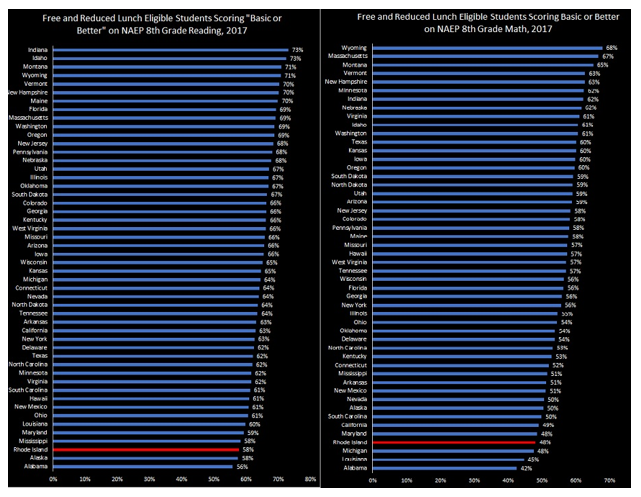 Johns Hopkins University’s School of Education on Wednesday released a 93-page report of the Providence, Rhode Island, Public School District that provides a useful cautionary tale on how not to structure a K-12 system, reminding us that big spending and strong unions fail to produce learning for kids.
Johns Hopkins University’s School of Education on Wednesday released a 93-page report of the Providence, Rhode Island, Public School District that provides a useful cautionary tale on how not to structure a K-12 system, reminding us that big spending and strong unions fail to produce learning for kids.
Among the report’s highlights:
· The great majority of students are not learning on, or even near, grade level.
· With rare exception, teachers are demoralized and feel unsupported.
· Most parents feel shut out of their children’s education.
· Principals find it very difficult to demonstrate leadership.
· Many school buildings are deteriorating across the city, and some are even dangerous to students’ and teachers’ wellbeing.
You can view local television coverage of the “devastating” report here and here.
Meanwhile, the Digest of Education Statistics shows that Rhode Island spent a total of $16,496 per pupil in the 2014-15 school year compared to Florida’s per-pupil expenditure of $9,962.
The John Hopkins researchers visited multiple Providence classrooms and found reading classes where no one was reading and French classes where no one was speaking French. They did, however, observe kindergarten students punching each other in the face, students staring at their phones during class, and students communicating over Facetime during class. One can only shudder to think what might be going on when university researchers aren’t touring the school.
Twenty-five kids in a Providence classroom will generate a bit over $400,000 in revenue. That money gets spent on something, but alas, there isn’t much learning happening.
Now at this point in the conversation, some of our friends with reactionary traditionalist K-12 preferences often trot out the litany of poverty in the district. We can’t expect kids to avoid Face-timing in class overcome the burdens of poverty until X, Y or Z is done. Well, all states have low-income kids, so how does the academic performance of low-income students in Rhode Island compare to those in other states?

National Assessment of Educational Progress (NAEP) scores strongly reinforce the findings of the Johns Hopkins researchers. For those of you squinting at your iPhone, that is Reading on the left, Math on the right. The percentage of students eligible for free or reduced-price lunch who scored “basic or better” is shown on both charts.
These results are nothing less than sickening for Rhode Island, given the gigantic taxpayer investment in the system. Mississippi beats Rhode Island on both tests, and Rhode Island’s poor children score much closer to poor children in Alabama than they do to poor children in neighboring Massachusetts.
Florida is the only state with a majority minority student population to crack the Top 10 in either Reading or Math in 2017. It is unfortunate that a vocal minority in Florida seems desperate to kill the policies leading to that improvement, and hell-bent on adopting a policy mix closer to that of Rhode Island.



This is very sad. In New York City where I work and was raised the school system is totally failing the students and this seems to be a trend country wide in our nations urban schools. This is not good for the country. I won’t politicize this, but I think it’s obvious.
You would think by now that the Democrat/Education Union Complex’s track record of decades-long failure would precipitate wholesale change. But that’s only because some people actually believe the interest of the parents and children come first. How they can believe that when a union’s entire reason for being is to promote and protect the interests of its members–unions who contribute campaign funds almost solely to Democrats who back them every step of the way–is beyond imagining.